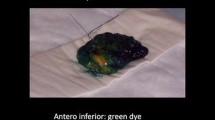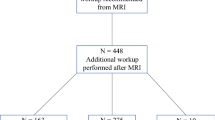Abstract
Background: The aim of the study was to evaluate the efficacy of contrast-enhanced magnetic resonance imaging (MRI) for preoperative assessment of palpable breast cancer after sonographically guided percutaneous core-needle biopsy.
Methods: Thirty-six breast cancers in 35 women that had been diagnosed by sonographically guided core-needle biopsy prior to subsequent MRI were evaluated in this retrospective study. Radiological and pathological reports, multiplicity, retroareolar involvement, and the size of the breast cancers were reviewed. The cancer sizes, as derived from sonography and enhanced MRI, were correlated with histological size in greatest diameter by means of Pearson’s correlation. The threshold value for significance was set at P < .05.
Results: Synchronous breast cancers were revealed in the index cases by means of enhanced MRI (10), sonography (8), and mammography (7). Two of the 36 index cancers (5.6%) benefited from MRI assessment. Retroareolar cancer extension was observed with enhanced MRI in five index cancers. Of these, one was also noted on both a sonogram and a mammogram. Four of the index cancers (11.1%) benefited from the enhanced MRI. Overall, five index cancers (13.9%) benefited from the enhanced MRI. With a gold standard of histology, the mean cancer sizes were underestimated by sonography and overestimated by enhanced MRI. In comparison with sonography, a stronger association was noted between MRI and histological measurements, with coefficients of 0.657 and 0.882, respectively (P < .001).
Conclusions: In a clinical setting, MRI for preoperative assessment of breast cancers is warranted. Minimally invasive, percutaneous core-needle biopsy did not alter the clinical efficacy of the MRI evaluation.
Similar content being viewed by others
REFERENCES
Friedrich M. MRI of the breast: state of the art. Eur Radiol 1998; 8: 707–25.
Harms SE. Breast magnetic resonance imaging. Seminin Ultrasound CT MR 1998; 19: 104–20.
Kuhl CK, Mielcareck P, Klaschik S, et al. Dynamic breast MR imaging: Are signal intensity time course data useful for differential diagnosis of enhancing lesions? Radiology 1999; 211: 101–10.
Orel SG, Schnall MD, LiVolsi VA, Troupin RH. Suspicious breast lesions: MR imaging with radiologic-pathologic correlation. Radiology 1994; 190: 485–93.
Hilton SV, Leopold GR, Olson LK, Willson SA. Real-time breast sonography: application in 300 consecutive patients. AJR Am J Roentgenol 1986; 147: 479–86.
Rubin E, Mennemeyer ST, Desmond RA, et al. Reducing the cost of diagnosis of breast carcinoma: impact of ultrasound and imaging-guided biopsied on a clinical breast practice. Cancer 2001; 91: 324–32.
Anastassiades O, Iakovou E, Stavridou N, Gogas J, Karameris A. Multicentricity in breast cancer. A study of 366 cases. Am J Clin Pathol 1993; 99: 238–43.
Vaidya JS, Vyas JJ, Chinoy RF, Merchant N, Sharma OP, Mittra I. Multicentricity of breast cancer: whole-organ analysis and clinical implications. Br J Cancer 1996; 74: 820–4.
Coveney EC, Geraghty JG, O’Laoide R, Hourihane JB, O’Higgins NJ. Reasons underlying negative mammography in patients with palpable breast cancer. Clin Radiol 1994; 49: 123–5.
Stavros AT, Thickman D, Rapp CL, Dennis MA, Parker SH, Sisney GA Solid breast nodules: use of sonography to distinguish between benign and malignant lesions. Radiology 1995; 196: 123–34.
Fornage BD. Sonographically guided needle biopsy of nonpalpable breast lesions. J Clin Ultrasound 1999; 27: 385–98.
Kolb TM, Lichy J, Newhouse JH. Occult cancer in women with dense breasts: detection with screening US-diagnostic yield and tumor characteristic. Radiology 1998; 207: 191–9.
Park JM, Yoon GS, Kim SM, Ahn SH. Sonographic detection of multifocality in breast carcinoma. J Clin Ultrasound 2003; 31: 293–8.
Fischer U, Kopka L, Grabbe E. Breast carcinoma: effect of preoperative contrast-enhanced MR imaging on the therapeutic approach. Radiology 1999; 213: 881–8.
Orel SG, Schnall MD, Powell CM, et al. Staging of suspected breast cancer: effect of MR imaging and MR guided biopsy. Radiology 1995; 196: 115–22.
Tan JE, Orel SG, Schnall MD, Schultz DJ, Solin LJ. Role of magnetic resonance imaging and magnetic resonance imaging guided surgery in the evaluation of patients with early-stage breast cancer for breast conservative treatment. Am J Clin Oncol 1999; 22: 414–8.
Hlawatsch A, Teifke A, Schmidt M, Thelen M. Preoperative assessment of breast cancer: sonography verus MR imaging. AJR Am J Roentgenol 2002; 179: 1493–501.
Liberman L, Morris EA, Dershaw DD, Abramson AF, Tan LK. MR imaging of the ipsilateral breast in women with percutaneously proven breast cancer. AJR Am J Roentgenol 2003; 180: 901–10.
Osteen RT. Selection of patients for breast conserving surgery. Cancer 1994; 74: 366–71.
Yang WT, Lam WW, Chwung H, Suen M, King WW, Metreweli C. Sonographic, magnetic resonance imaging and mammographic assessments of preoperative size of breast cancer. J Ultrasound Med 1997; 16: 791–7.
Davis PL, Staiger MJ, Harris KB, et al. Breast cancer measurements with magnetic resonance imaging, ultrasonography, and mammography. Breast Cancer Res Treat 1996; 37: 1–9.
Cheung YC, Chen SC, Su MY, et al. Monitoring the size and response of locally advanced breast cancers to neoadjuvant chemotherapy (weekly paclitaxel and epirubicin) with serial enhanced MRI. Breast Cancer Res Treat 2003; 78: 51–8.
Davis PL, McCarty KS Jr. Magnetic resonance imaging in breast cancer staging. Top Magn Reson Imaging 1998; 9: 60–75.
Cheung YC, Lo YF, See LC, Chen SC, Chao TC. Hemodynamic parameters by color Doppler ultrasound and dynamic enhanced magnetic resonance imaging on palpable T1 breast cancers. Ultrasound Med Biol 2003; 29: 881–6.
Boetes C, Mus RD, Hollan R, et al. Breast tumors: comparative accuracy for MR imaging relative to mammography and US for demonstrating extent. Radiology 1995; 197: 743–7.
Author information
Authors and Affiliations
Corresponding author
Rights and permissions
About this article
Cite this article
Cheung, YC., Wan, YL., Lo, YF. et al. Preoperative Magnetic Resonance Imaging Evaluation for Breast Cancers After Sonographically Guided Core-Needle Biopsy: A Comparison Study. Ann Surg Oncol 11, 756–761 (2004). https://doi.org/10.1245/ASO.2004.12.008
Received:
Accepted:
Issue Date:
DOI: https://doi.org/10.1245/ASO.2004.12.008




